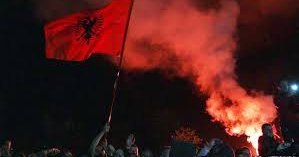On October 14th, the game between Albania & Serbia in Belgrade had to be stopped shortly before half-time. A drone was flown over the stadium. It carried a flag which has been widely reported as representing ‘Greater Albania’. We are told this is a nationalist theory claiming some lands currently belonging to Greece, Serbia and Macedonia should belong to Albania, for various historical reasons, based on what looks like ethnic beliefs. The story goes on that the game had to be interrupted, then called off for good because a Serbian player seized the flag, a brawl between players ensued and, finally the pitch was invaded by ‘supporters’.
All of this narrative must be treated with caution. Overnight, many people seem to have become long-time specialists of Balkan nationalist theories or of nationalism-related crowd troubles in football and elsewhere. The analysis may easily remain superficial. For example: what the videos seem to show is a black flag with the crest of Albania, the word ‘autochtonous’ (interestingly in English) and a portrait – the information on who is pictured does not appear to be available. I would be very interesting to know how the link with the ‘Greater Albania’ theories are made at this point – perhaps justifiably so. The videos also seem to suggest the game was stopped by the referee before the drone was flown – some, not all, commentators refer to flares being thrown onto the pitch. Furthermore, the very vague notion of ‘supporters’ seems to be widely abused here again. Who can testify that the members of the audience who raced onto the field are really long-term supporters of the Serbian team and not spectators with a political agenda, with very small ties to the Serbian national team? (sources indicate Albanian spectators were not allowed to buy tickets for the games.)
None of these points are minor. This region of Europe has a rather long history of interlinked fights sometimes even leading to the full-blown wars we know too well. The more one delves into nationalist issues in the Balkans, the more complex they seem to become. The varying (and often reconstructed) memories these issues have left even adds another layer of complexity. Any serious analysis of troubles happening in football stadia must be very careful of the context in which they take place.
As shown in previous research, and the one we are doing for the EU-funded FREE project on identity dynamics, football’s ability to create symbols for a number of identities is remarkably similar in all countries. Logos, jerseys, flags, names, public figures (players, managers, presidents…) all come to symbolise various aspects of identities. The wannabe ‘supporter’ can pick (consciously or not) the identity aspect in the club that best resemble their own identity beliefs. For example, a club can symbolise Scotland for a supporter and the UK for another… However, the very identities channelled through football are not the same in peaceful and belligerent countries. The degree of violence present in a stadium also depends largely on the level of violence which is common in a given society. Daily-life accepted violence is probably more common in countries which were more recently at war, or where inequalities are more important.
Football, sport, cannot be blamed for all the ills by which it is affected. Like the body of a guitar or violin, a sports stadium is a ‘bowl’ where any noise resonates very loudly due to the size and density of the crowd. The noise resonates even more so when it is amplified by the microphones of the media. Football being the most popular and most widely reported on sport in Europe, it makes sense for political activists to stage their claims in the football context (whether football actually matters to them, or not). Collaboration with international, national and local authorities is necessary if football governing bodies want their sport to stop echoing the ills of the social or national context where sport takes place and for which sport is not responsible. In this context, the agreement signed yesterday between the EU and UEFA will hopefully be a step in the right direction [1].
1. europa.eu/rapid/press-release_IP-14-1134_en.htm
picture: @Deutsche Welle

Follow the comments: |
|
